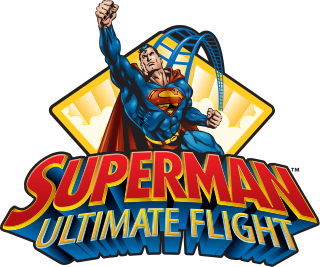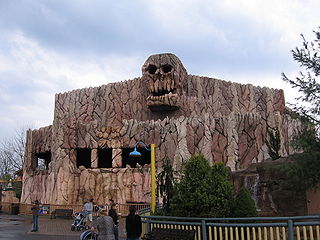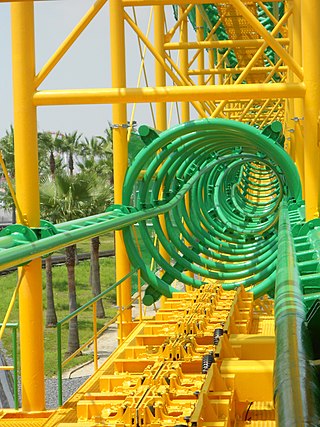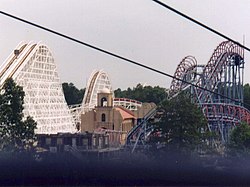
Six Flags Great Adventure is an amusement park located approximately 20 miles southeast of Trenton in Jackson, New Jersey. Owned and operated by Six Flags, the park complex is situated between New York City and Philadelphia and includes a water park named Hurricane Harbor. It first opened to the public as simply Great Adventure in 1974 under the direction of restaurateur Warner LeRoy. Six Flags acquired the park in 1977. The park is located right off of Interstate 195 and is along Monmouth Road.

Batman: The Ride is an inverted roller coaster based on the DC Comics character Batman and found at seven Six Flags theme parks in the United States. Built by consulting engineers Bolliger & Mabillard, it rises to a height of between 100 and 105 feet and reaches top speeds of 50 mph (80 km/h). The original roller coaster at Six Flags Great America was partially devised by the park's general manager Jim Wintrode. Batman: The Ride was the world's first inverted roller coaster when it opened in 1992, and has since been awarded Coaster Landmark status by the American Coaster Enthusiasts. Clones of the ride exist at amusement parks around the world.

Great American Scream Machine was a steel roller coaster located at Six Flags Great Adventure in Jackson Township, New Jersey. The 173-foot-tall (53 m) ride opened in 1989 as the tallest and fastest looping roller coaster in the world, reaching a maximum speed of 68 mph (109 km/h). It was designed by Ron Toomer and manufactured by Arrow Dynamics, which built two other coasters with similar layouts – Shockwave at Six Flags Great America and Viper at Six Flags Magic Mountain. Great American Scream Machine featured seven inversions including a batwing and double corkscrew. Records set by the ride were succeeded by Viper the following year in 1990. It operated until July 2010 and was replaced by a stand-up roller coaster, Green Lantern, in 2011.

Green Lantern, formerly known as Chang, is a stand-up roller coaster located at Six Flags Great Adventure in Jackson Township, New Jersey. Green Lantern stands 155 feet (47 m) tall and features a top speed of 63 miles per hour (101 km/h). The 4,155-foot-long (1,266 m) ride features five inversions and a duration of approximately 21⁄2 minutes. This steel coaster was designed and built by Swiss manufacturer Bolliger & Mabillard.

The Riddler's Revenge is a steel stand-up roller coaster located at Six Flags Magic Mountain. Manufactured by Bolliger & Mabillard, the ride opened as the park's eleventh roller coaster on April 4, 1998, setting multiple world records among stand-up coasters. Originally located in the Movie District section of the park, which later became Metropolis in 2017, The Riddler's Revenge was also the park's single biggest investment at a cost of $14 million. It features a height of 156 feet (48 m), a maximum speed of 65 mph (105 km/h), six inversions, and a track length of 4,370 feet (1,330 m).

El Toro is a wooden roller coaster located at Six Flags Great Adventure in Jackson Township, New Jersey. Designed by Werner Stengel and manufactured by Intamin, the ride opened to the public on June 11, 2006. Intamin subcontracted Rocky Mountain Construction (RMC) to build the ride, and the coaster's track was prefabricated, allowing for quicker installation and lower construction costs. El Toro is the main attraction of the Mexican-themed section of the park, Plaza Del Carnaval. It replaced another roller coaster, Viper, which closed following the 2004 season.

Batman & Robin: The Chiller was a dual-tracked, launched roller coaster located at Six Flags Great Adventure in Jackson Township, New Jersey. Designed by Premier Rides, the ride was themed to the 1997 film Batman & Robin.

The Pipeline Coaster is a roller coaster model where the trains ride between the tracks as opposed to a traditional roller coaster where they ride above them. The concept was first developed by Japanese ride company TOGO, and was known as the Ultra Twister. They built six installations of the design, and four are still in operation. Arrow Dynamics created an alternate version of the concept, but it never made it past the prototype stage in development. Intamin also experimented with the pipeline concept and built and relocated one model, known as the Spiral Coaster, but it is no longer operating. Some of the drawbacks of the design include the need for large, uncomfortable over-the-shoulder restraints as well as the obstruction of the riders' view by the enclosed pipe structure.

Superman: Ultimate Flight is the name of three flying roller coasters currently operating at three Six Flags amusement parks in the United States, those being Six Flags Over Georgia, Six Flags Great Adventure and Six Flags Great America. Each of these steel coasters were designed and built by Swiss manufacturer Bolliger & Mabillard and opened in 2002 and 2003. Since 2003, Six Flags has installed Superman: Ultimate Flight in three of their parks. Themed to the popular comic book character, Superman: Ultimate Flight simulates flying by positioning its passengers parallel to the track, supported by harnesses and facing the ground through most of the ride. In the station, riders board the train sitting down. After the train is locked and checked, the trains are raised into the flying position. After the ride, the seats are lowered back into the sitting position for the next round of riders.

TOGO was a Japanese amusement ride company that built roller coasters, giant wheels, carousels, flumes, dark rides, sky cycles and other amusement rides.

Skull Mountain is an enclosed roller coaster located at Six Flags Great Adventure in Jackson Township, New Jersey. Designed and manufactured by Intamin, the ride opened to the public on June 3, 1996.

Viper is a steel roller coaster located in the Baja Ridge area of Six Flags Magic Mountain in Valencia, California. Viper is the last operating roller coaster with seven inversions to be built by American manufacturer Arrow Dynamics. The other two, Shockwave at Six Flags Great America and the Great American Scream Machine at Six Flags Great Adventure, were demolished in 2002 and 2010, respectively. The roller coaster replaced a HUSS ride type named Condor.

Volcano: The Blast Coaster, or simply Volcano, was an inverted roller coaster located at Kings Dominion in Doswell, Virginia, United States. Designed by Werner Stengel, it was the first launched roller coaster manufactured by Intamin and the first of its kind in the world to be inverted. Its launch mechanism utilized linear induction motor (LIM) technology. After a series of delays, Volcano opened to the public on August 3, 1998. A portion of the ride was enclosed inside an artificial mountain, constructed in 1979, which previously housed other attractions. Following nearly two decades of operation, Volcano abruptly closed a few weeks into the 2018 season, and the closure became permanent during the following offseason.

Shockwave was a roller coaster manufactured by Arrow Dynamics at Six Flags Great America in Gurnee, Illinois. Standing 170 feet (52 m) tall and reaching speeds of 65 miles per hour (105 km/h), it opened in 1988 as the world's tallest and fastest looping roller coaster with a record-breaking seven inversions: three vertical loops, a boomerang, and two regular corkscrews. Shockwave was closed in 2002 and has been dismantled.

Ultra Twister was a steel roller coaster located at Six Flags Great Adventure from 1986 to 1988 and then at Six Flags AstroWorld from 1990 until that park was closed and demolished by Six Flags in 2005. The ultratwister-design is that of a pipeline roller coaster, created by Japanese company TOGO.

Batman The Escape was a stand-up roller coaster located at Six Flags AstroWorld in Houston, Texas, United States. Manufactured by Intamin, the ride featured one inversion and originally opened as Shockwave at Six Flags Magic Mountain in 1986. After briefly operating at Six Flags Great Adventure, it was moved a second time to AstroWorld, where it reopened in 1993 as Batman The Escape. The coaster operated there until the park's permanent closure in 2005. The track was eventually moved to Six Flags Darien Lake, placed into storage, and never reassembled.
Lightnin' Loops was a pair of Shuttle Loop roller coasters that were originally installed at Six Flags Great Adventure in Jackson, New Jersey. The ride consisted of two identical tracks, both of which were later relocated and renamed: the still-extant Diamond Back at Frontier City in Oklahoma City and the defunct Python at Six Flags America in Largo, Maryland.

Ultra Twister is a pipeline roller coaster located at Nagashima Spa Land in Mie Prefecture, Japan. Built by TOGO, the ride opened to the public in 1989. It was moved from its original location in 1989 to a new location in 2011, which sits further north inside the same park. It is also one of the few Ultratwister models from TOGO still in operation.

The Jersey Devil Coaster is a single-rail roller coaster located at Six Flags Great Adventure in Jackson Township, New Jersey. The roller coaster was built by Rocky Mountain Construction (RMC). It is themed to the Jersey Devil, a mythical creature rumored to live in the New Jersey Pine Barrens. The roller coaster is 3,000 feet (910 m) long and contains a 130-foot (40 m)-tall lift hill and three inversions. The Jersey Devil Coaster uses four trains, each containing 12 seats, which achieve a maximum speed of 58 miles per hour (93 km/h).

















